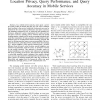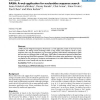405 search results - page 5 / 81 » Detecting dominant locations from search queries |
PVLDB
2010
13 years 8 months ago
2010
The tremendous growth of the Internet has significantly reduced the cost of obtaining and sharing information about individuals, raising many concerns about user privacy. Spatial...
SSDBM
2009
IEEE
14 years 4 months ago
2009
IEEE
Abstract. Real-life spatial objects are usually described by their geographic locations (e.g., longitude and latitude), and multiple quality attributes. Conventionally, spatial dat...
SIGIR
2008
ACM
13 years 9 months ago
2008
ACM
Address geocoding, the process of finding the map location for a structured postal address, is a relatively well-studied problem. In this paper we consider the more general proble...
ICDE
2008
IEEE
14 years 11 months ago
2008
IEEE
In a mobile service scenario, users query a server for nearby points of interest but they may not want to disclose their locations to the service. Intuitively, location privacy may...
SCFBM
2008
13 years 9 months ago
2008
: FASH (Fourier Alignment Sequence Heuristics) is a web application, based on the Fast Fourier Transform, for finding remote homologs within a long nucleic acid sequence. Given a ...


